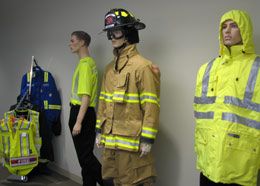| Editor’s note: Be sure to also check out Jeffrey Stull’s column, Focus on Turnout Gear. |
By Cristi Laquer
FireRescue1 Staff
 Photo Cristi Laquer A display at 3M in St. Paul, Minn., shows some of the variation in high-visibility garments for first responders. |
WASHINGTON — Firefighters may have one more thing to consider when tackling car fires and other roadway incidents from next year on – the use of a safety vest.
Proposed updates to the Federal Highway Administration’s Manual on Uniform Traffic Control Devices would require all first responders to wear high-visibility safety vests any time they operate near a roadway.
Firefighters still have time to voice their opinion, with the seven-month public consultation period not coming to an end until July 31. Some feel turnout gear already carries enough high-visibility trim in itself and that the additional use of vests could be unwieldy for firefighters at incident scenes.
“Firefighters who carry vests anyway may just go along with this and say, ‘well, a regulation is a regulation,’” said Tim Gardener, regulatory affairs manager for 3M’s occupational health and safety division, which produces many high-visibility products, including apparel.
“But firefighters have unique problems, such as when they wear an SCBA, what are they going to do with their vest? If they step out of the street and go into a fire, what are they going to do with their vest?”
However, Billy Goldfeder, of FirefighterCloseCalls.com, said he is in favor of the use of vests on roadways and making firefighters as visible as possible.
“It only makes sense; after all, wouldn’t your family want you to be visible while operating on the roadway?” he said in a post on his site.
“Speaking as one who was struck in the late 90s, whatever we can do in order to not be struck simply makes sense. At the very minimum, the low cost, lightweight vests make it where clueless drivers on the highway have a better chance to see us along with traffic management, blocking, etc.”
Proposed changes
The updated 2003 Manual on Uniform Traffic Control Devices (MUTCD) is due to come into effect in 2009 at an as-yet undetermined date. The document is used by the Federal Highway Administration to standardize all traffic control devices from street signs to worker apparel nationwide. Part 6 of the MUTCD, named ‘Temporary Traffic Control,’ sets the rules for first responders at emergency scenes, with states required to adopt the MUTCD or a substantially similar document to govern their road services.
The proposed changes to section 6E.02 High-Visibility Safety Apparel would require all first responders and any other roadside worker to wear ANSI 107-2004 compliant vests any time they work near roadways. It would also allow ANSI 207-compliant vests, which were designed primarily for law enforcement officers, according to Gardener.
However, there are numerous difficulties in combining an ANSI vest with turnout gear. The new proposals require fluorescent background material, but as Gardener points out, “there is no background material that is ANSI compliant that is also flame resistant to NFPA 1971 requirements.” In addition, he said, ANSI vests currently aren’t designed to interact with other firefighter gear such as SCBAs. A report by The University of Michigan’s Transportation Research Institute (UMTRI) also found vests do not make firefighters more conspicuous than NFPA 1971 compliant turnout gear.
Alternative visibility gear
The study, published in April, focused on the conspicuity of first-responder safety garments. Researchers found no significant difference in visibility between public safety vests and standard turnout gear, despite the lack of fluorescent background material on the latter.
“The UMTRI report says, ‘You have as much conspicuity wearing turnout gear, you have enough visibility to determine the human form,’” said Pat Freeman, technical services director of Globe Manufacturing, a turnout gear producer. “Does it meet ANSI? No. Is it adequate? Yes.”
Gardener said firefighters need to have the option of being able to use their turnout gear to comply. “ANSI garments aren’t the only way to create effective visibility,” he said. “The NFPA has put a lot of time, effort and fieldwork into demonstrating the effectiveness of the 1971 visibility package. Perhaps most importantly, [turnout gear] is completely compatible with firefighters’ environment.”
Have your say
With the public consultation program still running, the Federal Highway Administration said firefighters and others still have time to voice their opinion – and that they will be listened to.
Ken Wood, traffic operations engineer for the organization, said, “One comment could provide enough information to revise the proposal, especially if there is proper documentation provided to support it.”
The Minnesota state statute (5205.0030) equivalent to the MUTCD accepts the ANSI standard, but also contains a single sentence exempting firefighters from wearing vests over turnout gear. It reads, “For fire protection personnel, compliance with NFPA No. 1971 is acceptable.”
“If FHWA adopts [the MUTCD without changes,]” Freeman said, “firefighters won’t have a choice.”
At www.regulations.gov, anyone can visit the “comments or submissions” section, and enter docket number “FHWA-2007-28977” to submit comments regarding the proposed change to section 6E.02. The FHWA also provides several copies of the MUTCD with the proposed changes highlighted at http://mutcd.fhwa.dot.gov/resources/proposed_amend/index.htm. The seven-month period to submit comments ends July 31. Firefighters can submit comments citing the UMTRI results and proposing an alternate wording that makes turnout gear an acceptable high-visibility garment. Copies of the UMTRI study can be requested by emailing mlmeff@umich.edu Globe Manufacturing has prepared a word document with more information on the upcoming MUTCD regulations. It includes a comments form and mailing address for sending paper copies of comments. Download the document here. |

